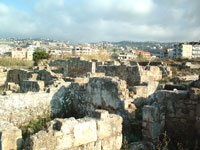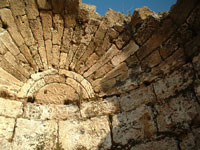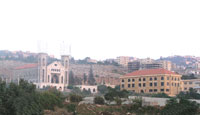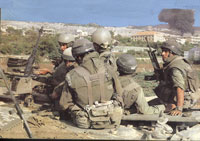
 |
| Discussion Board | Our Martyrs |
Jieh Through history Jieh, the fertile land according to the Greek sources,extends 7 km. along the Lebanese sea coast. It is the ancient city of Porphyreon whose history goes back to centuries before Christ. It was known at the time of the Phoenicians as a thriving natural seaport. This natural seaport where the continued functioning up to the present times. Many invaders passed through Porphyreon such as Tohomtmos the Egytian who landed his soldiers on its natural seaport in order to fight the North. Alexandre the Macedonian relaxed on its shore preparing for the attack on Tyre. The story of Porphyreon as a religious capital started according to the Old Testament when the prophet was outcast on its seashore. Jonah was for three days and three nights in belly of the sea-monster and its temple is still standing in Porphyreon (Jieh). Porphyreon became acquainted with the Christians religion in the early age ,as it was a holy passage on which walked the apostles on their way out of Jerusalem to preach to the nations. Paul used it as a passage in his many travels. Peter walked on its soil four times on his way to and from Antioche and Jerusalem. In Porphyreon was founded one of the first of the nine episopates in Lebanon during the fifth century AD. And in the sixth century Emperor Justinian built in Porhyreon one of the oldest churches in Lebanon (527-565). In the seventh century, Porphyreon proceeded with its aposolic mission and was represented in the Constantinople council held in the year 636 by its bishop Christopherios. During the Byzantine era and over six centuries, Porpheyreon was a very flourishing city. it was one of the most important commercial and religious cities on the Lebanese coast. Porphyreon had been know as a regional religious christian capital since the birth of Christianity. It held well its role in the modern centuries up to the year 1985,when its people were driven out of their homes on April 28,1985. It had 5 churhces, 2 convents and many religious sanctuaries. Furthermore, Jieh acquired a regional cultural reputation. It had the biggest educational college in the Iklim for 35 years (1950-1985). St Charbel's college, for the Lebanese Maronite Order of monks was the lighthouse of Iklim and the villages around it. Next to this college Jieh had the school of Our Lady of the Star for the Maronites Sisters of the Holy Family plus three public shcools. The dark period of the history of Porphyreon started with the Moslem invasion during the 7th century AD. Many of its genuine inhabitants left with the Byzantines. They feared the new invaders who transformed their flourishing city to a center of fighting, with them vanished all signs of civilization and prosperity. The years went by and Porphyreon suffered under the yoke of the Muslim rulers. Life in Jieh retuned to normal with the Crusaders in the 11th century. But the Mamlouks drove out the last christian from Porphyreon when the Crusaders left the area in the 13th century. In revenge they transformed the temple of Jonah into a mosque. The dark series of suffering and injustice continued until the 16th century. with the Ma'ns many christian families came to settle in the shouf villages with the Druzes who joind in during the crusaders time. The return of the christians to the shouf was due to the encouragement of the patriarchs,the persecution of the christians in Bcharri and Batroun and the relocation of the Patriarch to Majdel Mouch in the 16th and 17th centuries. The Christians apperaed again in Jieh with the emerging of the Chehabites in 1770. They took back what they lost for hundreds of years after the Muslim invasions. They started again to build the churches,to work the land and to raise silkworms, but things were not going as well as they had wished. The Druzes atttacked them many times. They burned the Churches ,the houses and the crops. The Church of our Lady was burned many times in 1841,1845,1860,1976 and finally in 1985. In 1845 the Druzes slaughtered the priest on the doorstep of the church and threw his dead body in the field. In the year 1860 Jieh witnessed the sacrifice of ist first martyrs during one of the battles with the Druzes. A number of travellers and orientalists passed through Jieh and recorded their impresion and their observations. They all admired its inhabitants for their patience,the strenght of their faith and their stubborness in face of difficulties,sufferings and temptations. Among these were Italian Msgr Mislin, the French scholar Ernest Renan with his assistant Gaillardot , as well as Joseph Goudard, Lammens and Henri Jalabert and other Jesuit priests. In 1863 Renan's discovered the Mosaic of the sanctuary of Porphyreon church which Daoud Bacha later offered as a valuable historic gift to the french Emperor Napoleon III. The family of Emir Bachie the second settled in Jieh, where they built a castel. The kings of Europe and the Popes sent their letters to the Chehabites in Jieh. Among them a letter from the Pope Gregory XVI in 1836 along with an icon of our Lady of the Star as a gift to the Emir. This icon was later kept in Church in Jieh until it disapeared during the 1976 invasion. During WWI Jieh suffered the loss of many martyrs because of Turkish oppresion. I WWII Jieh lost three martyrs in June 1941 as it was the target of hard shelling between the French and English armies between June 8 and Juky 12 1941. Under the Turkish yoke the people of Jieh endured suffering, hunger and unjustice which led to a first wave of immigration starting with end of the 19th century. They emigrated to different parts ofthe world especialy to the US, Brazil... The emigration continued and grew over the years and Australia became the destination of choice where parents and their kids were once again reunited. In January 1976 Jieh was the target of a Palestinian leftists and Muslims attacks casuing the displcacement of the whole town. But ever hopeful, Jieh Inhabitants returned few months later and tried to rebuild their totlaly burned homes. Jieh suffered once again during June 1982 when israel invaded Lebanon. As soon the Isralei withdrew in Sept 1983 fierce fighting raged until April 1985. Jieh lost tens of its young inhabitants among them eleven young men. In April 1985 Jieh suffered the loss of 20 martyrs in one singke day. The day shall come when the owner of the land shall return to spread the seeds back in their awaiting Jieh. By A. Azzi |
||||||
 |
||||||
 |
||||||
 |
||||||
 |
||||||
 |
||||||
 |
||||||
 |
||||||
 |
||||||
 |
||||||
 |
||||||
|
||||||